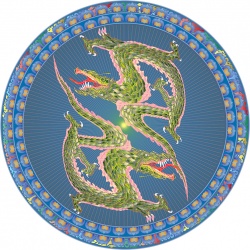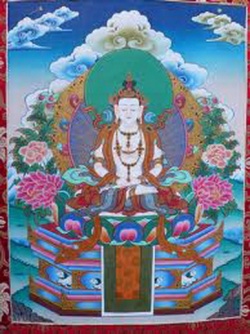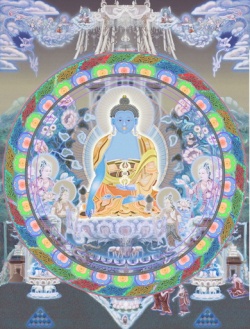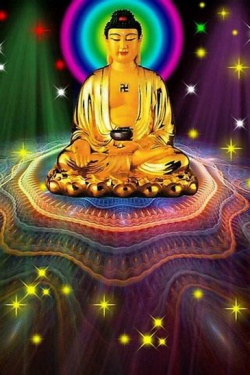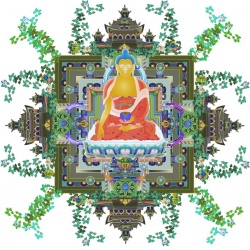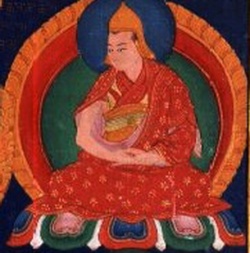A Taste of Buddhism
A Taste of Buddhism
Introduction
According to the recent distribution of religious populations, there are about 2 billion Christians, 1.2 billion Muslims but only about 785 million Buddhists, out of which about 102 millions in China and 89 millions in Japan and only 7 millions in India. Both Christianity and Islam, since their establishment, have been and are still being patronized and supported by their respective countries which provide religious education to children in schools and in monasteries. Their holy scriptures such as the Bible and the Koran are widely studied and are translated into different languages, and are easily accessed and comprehended by their peoples. Lacking in such favourable environment, Buddhism has yet to be generally understood by people of the world, except in the country of origin, India where Buddhism was first started and in China, Japan, Korean and other countries in south-east Asia.
The Rise of Buddhism
Buddhism is a religion and is also a philosophy, the latter of which is recognized as one of the academic disciplines in many universities. Its founder, Siddhattha Gautama (in Sanskrit language) lived in North India in 6th century BC. His father, Suddhodana was the ruler of the kingdom of the Sakyas (in modern Nepal). Gautama married a beautiful princess, Yasodhara , at the age of 16, leading a luxurious and comfortable life. However, he had been so confronted with the suffering of his people and with the reality of life, such as sickness, death, poverty and inequality etc., that he abandoned his princely life and left behind his wife and his child Rahula at the age of 29 to lead an ascetic life in search of solutions and deliverance.
At first, Gautama wandered about the Ganges valley studying with traditional religious leaders and famous teachers undergoing rigorously ascetic practices, like yoga, meditation and prolonged fasting. For six years, he did not attain his goal and finally he decided to end his asceticism and fasting, and to pursue his own way. He restored his health and continued with his meditation. At the age of 35, Gautama, under the Bodhi-tree, a papal tree, attained Enlightenment, after which he was known as Buddha or Bodhisattva (the Enlightened One).
Unlike other religious founders, Gautama neither claimed himself as Saviour, nor inspired from any god or external power. He attributed his realization and attainment to human endeavour and human intelligence. He believed that everyone has the potentiality to become a Buddha through one’s determination, efforts and wisdom. He encouraged his disciples not to seek refuge in or help from anybody else but themselves. For the remaining 45 years until his death at the age of eighty, Buddha taught adeptly without distinction to men and women, peasants and businessmen, nobles and the poor, according to their disposition, intelligence and level of comprehension, and helped them develop themselves to work out their own emancipation.
Buddha taught his disciples through discourses in Maghadi, a language similar to Pali, which was described as a soft, melodious and smooth-flowing language. At the end of each teaching,Buddha summarized his thoughts in gatha (a set of verses, stanza or songs) created in high tension with spiritual insight so that his disciples could easily memorize through repeated recitation and singing. Throughout his life time, there was not any written record of his teaching because Buddha considered both words and writings could never accurately described one’s own feelings and sensations to other people. It was only after his death that his disciples gathered in five prolonged councils to recite and to record in writing Buddha’s words of discourses and to be attested. It was in the fourth council and about four hundred years after Buddha’s death that the first set of written scripture was established forming the canonic texts comprised in the ‘three Baskets’ (Tripitaka) : namely the Discipline (Vinaya, in Sanskrit language), the Texts (Sutta) and a Summary of the Teaching (Abhidamma). All Buddhists regard Buddha, his teachings (Dharma), and the Order of Monks (Sangha), as the ‘Triple-Gem’, ‘Three Refuges’ or (Triratna).
After Buddha’s death and during each of the councils within the following five hundred years, there were disputes among Buddhist disciples in respect of Buddha’s teaching, his doctrines and disciplines. They broke up into two main groups or schools with different sects. One is called the System or School of the Elders (Theravada), which was considered to be the orthodox and original form of Buddhism and are accepted and followed mainly in Sri Lanka, Myanmar, Thailand, Cambodia and Laos etc., and is later named as ‘Small Vehicle’ (Hinayana). The other group was called ‘Great Vehicle’ (Mahayana), a form of Buddhism of later development, and largely followed in China, Japan, Korea and Tibet. The basic difference is that Hinayana emphasizes on individual’s deliverance or awakening while the latter emphasizes more on the awakening of the majority of common people.
The Changes and Development of Buddhism
After Buddha’s death, Buddhism gradually became one of the big religious groups in India. It had its glorious time in the 3rd century during the reign of the king Asoka who was converted into a Buddhist. Not only did he unite India but also help expand Buddhism from Central Asia to Greece and Indochina. He encouraged peaceful co-existence among other religions in India, such as Hinduism, Jainism and Islam. After this period, Buddhism suffered many setbacks when other racial and religious groups from Asia Minor began to invade India intermittently from 7th century onwards, occupying different parts of India and destroying many monasteries. It was between 12th and 13th century that Islam completely penetrated into India and eliminated Buddhism which, however, continued to exist in south-east Asia. On the other hand, Buddhism had spread into China since 2nd century and from China to Japan, and Korea. Through the joint efforts of Indian Buddhist missionaries and the Chinese scholars, who were converts of Buddhism in China, many Buddhist scriptures (sutta) were translated into classical Chinese. Buddhism took roots and developed steadfastly in China. Nowadays, Buddhism has long been mingling with Chinese Confucianism and Taoism and become part and partial of Chinese culture.
Essence of the Tenets of Buddhism
Unlike Christianity where Christian faiths can study the Holy Bible to understand Jesus Christ’s teaching, there are hundreds and thousands of scriptures in Buddhism which contain Buddha’s words, discourses and ways of practices in the language of Pali, Sanskrit and Chinese, which are not easily understood by non-Buddhists. Thanks to the efforts and hard work of many Buddhist scholars over the past hundred of years, Buddha’s teaching has been handed down to the present day world with translation of different languages. The basic tenets of Buddha’s teachings and philosophy in respect of his Ultimate Truth and the Reality of Life can be summarized in the Four Signs or Characteristics:
1. All conditioned things are impermanent (Samhkara Anitya)
2. All things in the universe (Dharma, in the broad sense of Buddhism) are without self ( Dharma Anitya),
3. All conditioned things are suffering (Samkhara Dukkha), 4. The Attainment of Nirvana.
1. All conditioned things are impermanent
According to the doctrine of Conditioned Genesis (Paticca-samuppada) in Buddhism, nothing in the world is absolute and independent. Everything is conditioned, relative, interdependent and interconnected. This theory of relativity can be described as follows: a. When this is, that is;
b. This arising, that arises;
c. When this is not, that is not;
d. This ceasing, that ceases.
Buddha states that all conditioned and non-conditioned things, ranging from humans, animals, plants and organism to nations and organizations, must undergo the process of arising, existence, disintegration and cessation in the course of their existence. There is nothing which is permanent, everlasting and unchanged,including the sun, the moon, the earth and every planet in the universe. In a human body, everyday thousands and millions of human cells die but at the same time millions and millions of new cells grow and develop to keep an individual alive until the human body degenerates and deceases. In this regard, Buddha declares,“ If it is the nature of arising, it has within itself the nature, the germ,of its cessation, and its destruction.” The duration of existence of ll conditioned and non- conditioned things in the history of the universe is just like a split of seconds. He also said that one should view all conditioned things in the world as dreams, mirages,bubbles, shadows; as well as dews and flashes. He considered that not only the world is in continuous flux and is impermanent, but also human life, from birth to getting old, sickness and death, is like a mountain river; there is not a moment, not an instant, not a second when it stops flowing.
2. All things in the universe (Dharma) are without self (Dharma Anitya) In Buddhism, Dharma can also be referred to everything which has its consistent form, specific quality and characteristics such as water, minerals, and plants that could be easily identified. This doctrine correlates significantly to another doctrine of Buddhism, The Five Aggregates (Pancaskandha) which include:
1) The Aggregate of Matter (Repakkhandha),
2) The Aggregate of Sensations (Vedanakkhandha),
3) The Aggregate of Perception (Sannakkhandha),
4) The Aggregate of Mental Formation (Samkharakkhandha), and
5) The Aggregate of Consciousness (Vinnanakkhandha).
According to Buddhism, a living being is composed of six elements: solidity, liquidity, heat, motion, space and consciousness. Solidity refers to the bone structure of the living being, water refers to the blood, heat refers to bodily temperature and motion refers to breath. The four elements, together with consciousness and the required space form the human body. These six elements are in turn represented by the Five Aggregates, which are categorized under two main groups - the physical aggregate and the mental aggregate. The physical aggregate refers to the Aggregate of Matter. The other Aggregates are grouped under the mental aggregate. These two groups of aggregates form the physical and mental parts of the human body and are exemplified by six important physical and sensual organs: the eye, the ear, the nose,the tongue, the body and the mind (brain and neural system). These internal faculties, through contacts with their corresponding objects in the external world, experience sensations, perception, mental formation leading to volitional activities and give rise to consciousness as follows:
Physical External World Mental Aggregates Aggregate Objects
(Matter)
Eye visible form visual consciousness, Ear sound auditory consciousness, Nose odour olfactory consciousness, Tongue taste gustatory consciousness, Body tangible things tactile consciousness,
It is the function of mental consciousness of the living being that is responsible for identifying external objects to assess and to make decisions. Consciousness is arising from conditions and is dependent on matter, sensation, perception, and mental formation. A living being, or an individual, or ‘I’ according to Buddhism, is only a convenient name or a label to the combination of these five aggregates. They are all impermanent, all constantly changing in a flux of momentary arising and disappearing, and there is no unchanging, everlasting, absolute substance like Self, Soul within and without. Since Dharma covers everything in the universe, conditioned or non-conditioned things, good or bad, relative or absolute, it does not have a being which could be called ‘I’ or ‘self’.
3. All conditioned things are suffering (Samkhara Dukkha) The concept and nature of Dukkha, in Buddhism, means more than suffering. It includes all kinds of suffering in life like birth, old age, sickness, association with unpleasant persons and conditions, separation from beloved ones and pleasant conditions, not getting what one desires, grief, lamentation, and distress etc. In addition, it also refers to suffering resulted from changes, and to the arising from conditioned states. In short, whatever impermanent is Dukkha.
This doctrine of Dukkha is also called the First Noble Truth, which, together with The Second Noble Truth (Samudaya), the arising or origin of Dukkha; The Third Noble Truth (Nirodha), the cessation of Dukkha; and the Fourth Noble Truth, (Magga), the way leading to the cessation of Dukkha, form the Four Noble Truths (Cattari Ariyasaccam). Buddha says, “ He who sees Dukkha sees the arising of Dukkha, sees the cessation of Dukkha, and sees also the path leading to the cessation of Dukkha.”
The Second Noble Truth helps individuals understand the arising or the origin of Dukkha. The important reasons is firstly, that living beings do not understand that all conditioned things are impermanent and that all conditioned things or Dharma do not have ‘self’; and secondly, due to an individual’s desire, lust and the craving ‘thirst’ (tanha), one chases incessantly after sensual love, fames, powers, moneys, luxuries, long life and the next life. They feed the lust and desire of the false ‘self’ and try to increase the possessions of the‘ self’. These volitional activities are described in Buddism as deeds or (karma), which are resulted from living beings’ ‘ignorance’. The accumulation of the karma, be they good or bad, will determine whether one would, in the next life, become heavenly beings, human beings, ‘asuras’ (between human beings and the lower level world), hungry ghosts, animals and be in hell in the Cycle of Existence (Samsara). Unless one attains heavenly level which is Dukkha free, one would continuously be in the Cycle of Existence to struggle with Dukkha life after life.
4. The Attainment of Nirvana
The most essential and important Buddha’s teaching is found in The Third Noble Truth (Nirodha), which is the Cessation o Dukkha. It refers to an individual’s emancipation, liberation, and freedom from suffering, as well as from the continuity of Dukkha. Since the main root of Dukkha is the ‘thirst’ (tanha), to uproot Dukkha or to eradicate the ‘thirst’ is to drive towards complete cessation. This can be done through the development of one’s intelligence and wisdom (Panna) which Buddha declared that all living beings can develop. With wisdom, one can calm down all conditioned things, give up defilements, detach from the ‘thirst’, see things as they are without ignorance and discover the secret of life that all forces feverishly produce the continuity of Samsara, the Cycle of Existence are in illusion. Then one would not produce any more karma-formation because there is no illusion and no more‘thirst’ for continuity. One will then see the Absolute Truth and attain Nirvana and become one of the happiest being in the world. In Buddhism, it is possible for one to realize Nirvana in this very life and it is not necessary to wait till one dies to attain it.
The way and means to enhance one’s wisdom and to realize Nirvana is through practising the Fourth Noble Truth (Magga), which is represented by the Noble Eightfold Path comprising eight steps:
1) Right Understanding,
2) Right Thoughts,
3) Right Speech,
4) Right Action,
5) Right Livelihood,
6) Right Effort,
7) Right Mindfulness,
8) Right Concentration.
In brief, they can be categorized into three inter-related parts: • the Ethical Conduct (Sila), including Right Speech, Right Action and Right Livelihood; • Mental Discipline (Samadhi), including Right Effort, Right Mindfulness and Right Concentration; and
• Wisdom (Panna), deriving from Right Understanding and Right Thought.
Through observing and practicing the Noble Eightfold Path, one can develop first, self- discipline in body, word, and mind; second,self-development in universal love and compassion for all living beings for the good and happiness of the many; and third, self purification and the formation of noble qualities of thoughts,including thoughts of selfless renunciation or detachment,thoughts of universal love and compassion, and thoughts of non-violence.
Buddha taught the above fundamental doctrines to his disciples after his Enlightenment and throughout the rest of his 45 years’ preaching. All his teaching and doctrines were dissipated in discourses with his disciples and but were infiltrated deeply into their minds and hearts and later transferred into all kinds of scriptures in Hinayana and in Mahayana.
Buddhism in the Present Day Life
For the past one thousand and five hundred years, Buddhism has been undergoing tremendous changes with the center of study and activities shifting from India to China, which, by now, has the largest Buddhist population with hundreds and thousands of Buddhist scriptures translated from Pali and Sanskrit into Chinese. Since the past two and three centuries, Buddhist scriptures have been translated into other national languages and Buddhism has been gradually spread and accepted by many other countries. Nowadays, one can learn or study Buddhism through proper channels with Buddhists and in monasteries.
Alternatively, one can study Buddha’s thoughts and doctrines in search of one’s philosophical interest. For people who want to do away with Buddhist rituals and ceremonies, they can study Buddhist teaching and doctrines for the purpose of developing self-discipline, mental culture or development. Buddhism requires its disciples to have faith in Buddha’s teaching, to fully comprehend his doctrines, to practice them consistently and to prove his words and teaching. Many people, through studying and practicing Buddha’s teaching including meditation, are able to attain cleansing the mind of impurities and disturbances, such as lustful desires, hatred, ill-will, indolence, worries and restlessness; and cultivate the qualities as concentration, awareness, intelligence, will, the analytical capacity, confidence, tranquility, joy and compassion.
Buddha’s teaching was based on universal love, compassion and most important of all, service to others. His teaching did not take life out of the context but as a whole in its social, economic and political aspects. That is the reason why Buddha’s teaching still prevails in the world of today. In one of his scriptures, Buddha clearly stated that poverty is the cause of immorality and crimes such as theft, falsehood, violence, hatred and cruelty. He suggested that crime cannot be eradicated by punishment but by improving the economic condition of the people. He said that there are four things which are conducive to an individual’s happiness: first, one should be skilled, efficient, earnest and energetic in whatever profession one is engaged in; second, one should protect one’s income which one earns righteously; third, one should have good friends who will help one away from evil; and fourth, one should spend reasonably, in proportion to one’s income, and live within one’s means.
For the good of mankind, Buddha advocated and preached non-violence, peace as its universal message, and did not approve any kind of violence or destruction of life. He stated that the whole country could become corrupt, degenerate and unhappy when the heads of its government, the ministers and administrative officers become corrupt and unjust. He considered a nation as a vast conglomeration of individuals. A nation or a state does not act. It is the individuals who think and who act. What is applicable to an individual is applicable to the nation. If hatred can be appeased by love and kindness on individual scale, surely it can be realized on the national and international scale too. He said that the only conquest that brings peace and happiness is self-conquest: one may conquer millions in battle, but he who conquers himself, only one, is the greatest of conquerors.
In summary, Buddhism, like many other religions preaches, love, peace and non-violence, which is desperately in need by peoples and nations of the world today. Buddha’s teaching should have tremendous influences on individuals and on all nations at large. If his teaching can be widely spread among peoples and nations and be practiced intensively and extensively, the world would become peaceful and joyful than what it is now.


